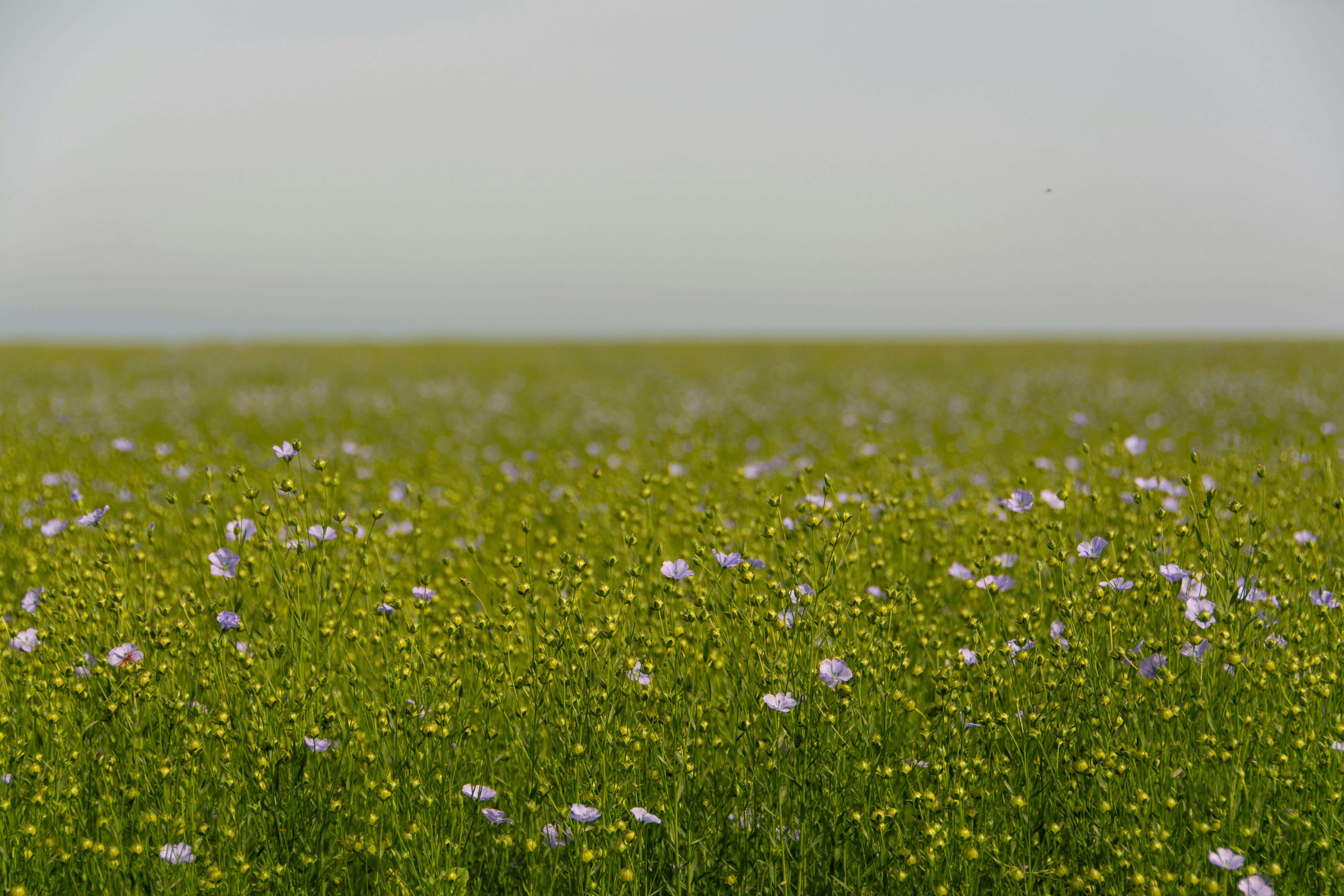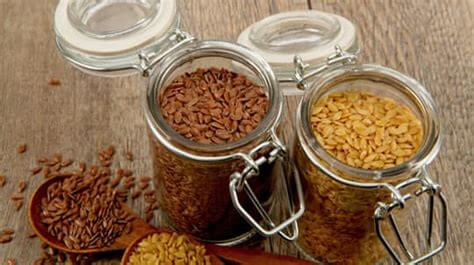Work
Long-Form Article
Portfolio
Flax - The Oldest Textile Crop Worth Its Weight in Gold
Flax is the oldest textile crop and is one of the oldest food crops. Flax was cultivated for food and textiles during the Neolithic period. Originally, knotting and netting were used to catch and carry food for hunter-gatherer civilizations. Eventually, twisting fibers together became lengths of thread while spinning lengths of thread together created textiles. Prior to industrialization, linen created from flax was valuable or "worth its weight in gold" (Close-Hainsworth). Egyptian and Mesopotamian civilizations used finely woven and died linen fabrics as a medium of exchange long before money was created. Linen also served as a status symbol and measure of wealth since hundreds of fine linen sheets were found in Egyptian tombs. Eventually, flax fiber was spun into thread and weaved into linen to be used in transportation. Linen was used for ships’ sails for the British Royal Navy and the Spanish Armada. Linen was used to create the wings of airplanes for both Allies and Central Powers during World War I. In North America, flax was not cultivated for food originally. It was cultivated for linen and linseed oil used in paint and linoleum. Today, flax is still cultivated for linen, but also for its nutritional value as a functional food.
Neolithic Cultivation of Flax
In Germany during the 19th century, pile dwellings were discovered around lakes and in bogs dating from the late Neolithic period to early Iron Age (4,000 to 3,400 B.C.) (Maier, Schlichtherle, 567-578). The pile dwellings provided evidence of large-scale flax production for textiles and food. Archaeological findings included spindle and hatchel tools used for processing flax fibers into thread for textiles (Maier, Schlichtherle, 567-578). Work-in-progress linen textiles along with completed textiles were also found. Evidence of lightly grinding or pounding capsules to remove seeds and burned flax seeds found at the bottom of ceramic pots indicates that Neolithic people cultivated flax seeds for food (Maier, Schlichtherle, 567-578). Flax is one of the oldest cultivated food crops (Maier, Schlichtherle, 567-578).
Neolithic people understood how to perform both the water and field retting processes for flax still used today (Maier, Schlichtherle, 567-578). Retting is a process whereby the outer woody part of the flax plant is softened with moisture and left to rot to remove the outer layers from the inner fibers to use the fibers for textiles. Tools resembling modern day scutches and heckles were made in Neolithic times (Maier, Schlichtherle, 567-578). Finely threaded nets made from flax fiber were found with no outer stalks in the fibers (Maier, Schlichtherle, 567-578). This cannot be done without the proper tools. This means that Neolithic people used methods for processing flax fiber into textiles equal to modern capabilities (Maier, Schlichtherle, 567-578). Archeologists found shoes made from flax bast fibers and clothing, nets, and other textiles made from finely woven flax fibers (Maier, Schlichtherle, 567-578). Linen and other textiles made from flax eventually replaced the fur and leather previously worn by Neolithic people. This indicates advanced craftsmanship of implements for processing and spinning flax fiber into fine thread (Maier, Schlichtherle, 567-578).

In total, 53 wetland settlements were discovered in Germany. All 53 sites grew, harvested, and processed flax for textiles, oil, and food (Maier, Schlichtherle, 567-578). Archeological evidence shows that two varieties of flax plants were cultivated in the late Neolithic period (Maier, Schlichtherle, 567-578). One type of flax plant was cultivated for larger seeds to be used for oil and food. This flax plant’s seeds were 40 percent oil. Another type of flax plant was cultivated with smaller seeds to be used for fiber to make textiles. Smaller flax seed plants were grown exclusively during the middle Neolithic period specifically for textile fibers (Maier, Schlichtherle, 527-533). From the middle Neolithic period (3400-2400 B.C), clay whorls with spindles appeared for the first time (Maier, Schlichtherle, 567-578). During this period, entire settlements were found that were devoted to cultivating flax for fibers to make textiles (Maier, Schlichtherle, 567-578). Smaller seeds were found in these settlements with no cereal residue meaning that growing flax during this period was strictly for fibers, not for food or oil (Maier, Schlichtherle, 567-578). Then around 3,000 B.C., a supposed "flax boom" occurred (Maier, Schlichtherle, 527-533). A new type of flax seed was introduced that greatly increased textile production. Sites found seemed to specialize exclusively in the cultivation and processing of flax for textiles (Maier, Schlichtherle, 527-533). This also resulted in flax production innovations involving tools and techniques (Maier, Schlichtherle, 527-533).
In Slovenia, about 40 Neolithic to Bronze Age (4600-1700 B.C.) pile dwellings were found (Tolar, Jacomet, Veluscek, et al. 207-222). Here too, archeologists found two types of flax plants specifically grown for either oil or fiber (Tolar, Jacomet, Veluscek, et al. 207-222). Like the pile dwellings found in Germany, the Slovenian pile dwellings demonstrated that this civilization of Neolithic people cultivated flax for the same reasons using the same methods.
In Egypt, linen fragments were found dating to around 5000 B.C. (Crawford). Egyptians used linen for bedding, sails, fishing nets, cording and funerary purposes. Egyptian mummies were wrapped in hundreds of yards of linen soaked in resins (Crawford, Smithsonian). The quality of linen used for mummy wrapping conveyed the social status of the deceased. Egyptians also used linen as a medium of exchange to pay taxes before money existed (al-Athir).

North American Cultivation of Flax
North America and Canada were the world’s largest producers of flax during the 1850s. Today, Canada is the largest producer of flax. According to Joshua MacFayden in Flax Americana: A History of the Fibre and Oil That Covered a Continent, flax is the second oldest human cultivated food crop in the world (after figs). The Latin name for flax, Linum usitatissimum, literally means "of greatest use." Flax is the oldest cultivated fiber crop (U.S. National Park Service). The Irish were one of the first to build the linen industry prior to the Great Potato Famine (MacFayden 25-57, 323-330). They made the linen used to make ships’ sails for the British Royal Navy, and later, for the wings of airplanes. The Irish brought flax cultivation and linen production to the Americas. Originally, flax produced in the Americas was not cultivated for food. It was strictly used for textiles including linen, upholstery, and cordage. Later, most flax crops were cultivated to produce linseed oil used in paint and linoleum products (MacFayden 25-57, 323-330).
Before industrialization, most farmers did not know how to grow flax and were unfamiliar with the crop, so flaxseed millers became flax farmers. Millers ploughed the soil, planted the seeds, and harvested the crops (MacFayden 25-57, 323-330). They pulled flax plants up by the roots by hand and then pressed the flax seeds into oil using the same processes and tools used since Neolithic times (MacFayden 25-57, 323-330). During wartimes, the U.S. and Canadian governments promoted the production of flax crops because linen (not cotton) was used to make soldiers’ uniforms and tents during the American Civil War (MacFayden 25-57, 323-330). Except for ramie, flax fiber (linen) has the greatest tensile strength of any natural fiber. Because flax has a naturally high pectin content, fibers bind together making a textile made from flax fibers water resistant (Close-Hainsworth). Moisture makes the fibers 20 percent stronger, which is why ships’ sails were made from linen (Close-Hainsworth).

In 1912, U.S and Canadian flax crops occupied five million acres of land, the most ever cultivated at one time in human history. During WWI, the Federal Department of Agriculture distributed free flax seeds to farmers with instructions for cultivating. One acre of flax equaled one set of airplane wings. During WWI (1914-1918), an American fighter aircraft called the "Sopwith Camel" utilized a high thread count durable linen textile for its wings (Close-Hainsworth). The 1911 British Avro Triplane and the 1916 German Albatross D III also had linen wings. After WWI, linseed oil from flax crops became "the most important oil-producing crop now grown in the country" (MacFayden 25-57, 323-330). During this era, North Dakota and the Great Lakes region of Canada became the world’s largest flax producers.
North Dakota and the Great Lakes region of Canada are prairie grasslands with cooler temperatures. Flax thrives in cooler temperatures and yields best on new breaking prairie grasslands making it a prime "prairie crop" (MacFayden 25-57, 323-330). It was often ranked second or third in overall market value after wheat and oats (MacFayden 25-57, 323-330). Linseed oil from flax was needed to produce mixed paint for horse carriages, barns, and buildings. In Buffalo, New York, linseed oil factories pervaded (MacFayden 25-57, 323-330). In 1913, Henry Ford rolled out the first assembly line vehicles and all were painted with linseed oil-based paint. Linseed oil dries naturally, but with boiling and refining, varnish and paint manufactures produced a product that dried and hardened very quickly. Linoleum was also produced by adding cork shavings to this finished product (MacFayden 25-57, 323-330).

During WWII (1939-1945), the flax industry experienced another expansion to produce textiles for troops and linseed oil for painting airplanes. This meant that growers of flax had to decide when planting seeds whether they were producing flax for oil or fibers. Either the oil or the fiber would become the byproduct of the other. If growers decided to plant for flax oil, letting the seeds mature meant that the fiber in the stalks would degrade (MacFayden 25-57, 323-330). On the other hand, harvesting the stalks before the seeds matured meant that the fiber was the most valuable commodity (MacFayden 25-57, 323-330). Eventually, the industrial complex in big cities outpaced millers in the country and replaced them. With lower costs for transportation, flax could be imported from other countries; therefore, flax production was outsourced to countries like Argentina and Uruguay (MacFayden 25-57, 323-330). Thus, global flax markets were created and flourished. By the 1950s, flax production began to decline due to manufacturers using cheaper synthetic materials for paint and linoleum (MacFayden 25-57, 323-330). Still, at this time, flax was not consumed as a dietary supplement in North America (MacFayden 25-57, 323-330).
Nutraceutical Industry Cultivation of Flax
By 1997, the nutraceutical industry had taken over flax production for its essential fatty acids nutritional supplements. Flax is considered a "functional food" for its physiological benefits. Ground flax meal is available at most grocery stores. It is high in soluble and insoluble fiber as well as omega 3, 6, and 9 fatty acids. Today, chickens are fed flax meal to produce eggs high in omega 3 while cows are fed flax meal to produce milk products high in omega 3.
The most bioactive compounds in flaxseeds that reduce chronic disease and certain cancers include lignans, alpha-linolenic acid (ALA), and fiber. ALA and lignans in flaxseed inhibit the growth of tumors. According to Sharma, Priyanka, and Sood in "Flaxseed: A Potential Functional Food Source," "Flaxseed contains between 75-800 times more lignans than grains, legumes, fruits and vegetables." Lignans regulate and bind to estrogen and testosterone hormones to inhibit breast cancer and prostate cancer tumors (Kajla, Sharma, Sood 1857-1871). The lignans in flaxseeds have been shown to reduce breast cancer mortality by 33 to 70 percent and "all-cause mortality by 40-53 percent" (Aliani, Austria, Maddaford, et al.). All flax lignans scavenge free radicals that contribute to cancer while one specific lignin, secoisolariciresinol diglycoside (SDG), helps to reduce cholesterol, hypertension associated with high blood pressure, atherosclerosis, and diabetes (Kajla, Sharma, Sood 1857-1871). Studies performed on obese postmenopausal women have shown that lignins inhibit release of estrogen stored in adipose tissue (fat cells) that contributes to development of breast cancer (Kajla, Sharma, Sood 1857-1871). Because lignins are an insoluble fiber, they help to lower blood glucose levels that contribute to insulin resistance and diabetes (Kajla, Sharma, Sood 1857-1871).

Omega 3 fatty acids from fish oil (DHA, EPA) and flaxseeds (ALA) have significant positive effects on skin and reduce the appearance of aging (Parikh, Maddaford, Austria, et al.). Essential fatty acids for humans include eicosapentaenoic acid (EPA) and docosahexaenoic acid (DHA). DHA and EPA are omega 3 long-chain fatty acids. DHA and EPA "are only found in fish and fish oil" (MacFayden 324) whereas alpha-linolenic acid (ALA) is derived from plant sources like flax seeds. ALA is a short-chain omega 3 fatty acid. The human body can convert small amounts of plant derived ALA into EPA and DHA, but the best sources for EPA and DHA are cold-water fish and seafood. (Note that insulin resistance and consumption of too much omega 6 fatty acids inhibit the human body’s ability to convert ALA into EPA and DHA.) A single flax seed’s oil content is 23 percent ALA (Kajla, Sharma, Sood 1857-1871). Therefore, flax has the highest yield of ALA, even more than canola and soybean oils (Kajla, Sharma, Sood 1857-1871).
ALA is an essential polyunsaturated fatty acid with anti-inflammatory, anti-thrombotic, and anti-arrhythmic properties (Kajla, Sharma, Sood 1857-1871). Flaxseed is the best source of omega 3 fatty acids for those who do not consume fish. However, like apple seeds, flaxseeds contain cyanogenic glycosides (cyanide). Cyanogenic glycosides interfere with iodine absorption of the thyroid gland and can create goiter and other thyroid disorders (Kajla, Sharma, Sood 1857-1871). One to two tablespoons of flaxseeds produce about 5-10 mg of hydrogen cyanide after ingesting (Aliani, Austria, Maddaford, et al.). It would take ingesting 50-60 mg of hydrogen cyanide to "cause acute toxicity" (Parikh, Maddaford, Austria, et al.). "The human body can routinely detoxify up to 100 mg/day of cyanide" while certain cooking and processing methods can effectively destroy this toxin altogether (Parikh, Maddaford, Austria, et al.). Flax produced for textiles has higher cyanogenic glycosides content than flax produced for seeds. Ripe seeds contain less cyanogenic glycosides than immature seeds (Kajla, Sharma, Sood 1857-1871). Also, the cultivar and location of crops affect cyanide content (Kajla, Sharma, Sood 1857-1871).
Humans cannot fully digest whole flax seeds but can digest flax seed meal. People purchase whole flax seeds and grind only enough for immediate use because flax seed meal does not keep as long as whole flax seeds. Flax seed meal will go rancid due to the high ALA fat content. Flaxseed or flax meal can be incorporated into smoothies, baked goods, pasta, snack bars, and cereals. Using small amounts in recipes will provide all the nutritional benefits without altering the taste and texture of food.

Conclusion
Linen was worth its weight in gold in antiquity and used as a medium of exchange. Flax straight from the field that had not been retted looked like straw. Spinning straw into gold and weaving fates is part of human myth, legend, and folktale. The 1812 Grimm fairytale, Rumplestiltskin, is a story about spinning straw into gold. In Sleeping Beauty, another Grimm fairytale published in 1917, the princess pricks her finger on a spindle and falls asleep for years. The original spindles were wooden implements used for spinning flax fibers into thread. China and India invented spinning wheels centuries before they began appearing in Europe during the 13th century (Close-Hainsworth). Prior to the spinning wheel, textiles were made with spindles and distaffs until looms were widely used in Europe by the 1500s. Historically, women who never married spent most of their lives spinning flax fibers into thread. That is where the word "spinsters" originates (Close-Hainsworth). It is also where "spinning a yarn" originates (Close-Hainsworth).
Works Cited
al-Athir, Talia. "From Flax to Fabric: Linen in Ancient Egypt." https://scarabsandsilk.com/from-flax-to-fabric-linen-in-ancient-egypt/ .
Aliani, Michel, Austria, J. Alejandro, Maddaford, Thane G., Parikh, Mihir, Netticadan, Thomas, Pierce, Grant N. "Dietary Flaxseed as a Strategy for Improving Human Health." www.mdpi.com/journal/nutrients 11(5):1171. doi: 10.3390/nu11051171. PMID: 31130604; PMCID: PMC6567199. 2019. Accessed 22 Sept. 2022.
Close-Hainsworth, Freyalyn., Spinning a Tale: Spinning and Weaving in Myths and Legends. Folklorethursday.com. https://folklorethursday.com/folklife/spinning-a-tale/. 2017. Accessed 22 Sept. 2022.
Dowdeswell, Molly. "The Story, Symbols and Powers of Freya, the Norse Goddess of Love" 2013 https://www.ancient-origins.net/myths-legends-europe/freya-norse-goddess-0017280. 2013. Accessed 22 Sept. 2022.
Herbig, Christoph., Maier, Ursula. "Flax for oil or fibre? Morphometric analysis of flax seeds and new aspects of flax cultivation in Late Neolithic wetland settlements in southwest Germany." Veget Hist Archaeobot 20, 527. 2011. https://doi.org/10.1007/s00334-011-0289-z. Accessed 22 Sept 2022.
Jacomet, Stefanie., Tolar, Tjasa., Veluscek, Anton. et al. "Plant economy at a late Neolithic lake dwelling site in Slovenia at the time of the Alpine Iceman." Veget Hist Archaeobot 20, 207-222. 2011. https://doi.org/10.1007/s00334-010-0280-0. Accessed 22 Sept. 2022.
Kajla Priyanka, Sharma Alka, Sood, Dev Raj. "Flaxseed-a potential functional food source." J Food Sci Technol. 2015 Apr;52(4):1857-71. doi: 10.1007/s13197-014-1293-y. Epub 2014 Feb 28. PMID: 25829567; PMCID: PMC4375225. 2015. Accessed 22 Sept. 2022.
MacFayden, Joshua. Flax Americana: A History of the Fibre and Oil That Covered a Continent. McGill-Queen’s University Press. 2018.
Maier, Ursula., Schlichtherle, Helmut. "Flax cultivation and textile production in Neolithic wetland settlements on Lake Constance and in Upper Swabia (south-west Germany)." Veget Hist Archaeobot 20, 567-578. 2011. https://doi.org/10.1007/s00334-011-0300-8. Accessed 22 Sept. 2022.
Smithsonian Institute. "Ancient Egypt: Egyptian Mummies." https://www.si.edu/spotlight/ancient-egypt/mummies. Accessed 12 Oct 2022.
U.S. National Park Service. "Flax Production in the Seventeenth Century - Historic Jamestowne Part of Colonial National Historical Park." nps.gov, www.nps.gov/jame/learn/historyculture/flax-production-in-the-seventeenth-century.htm.
Crawford, Benna. "Linen in Ancient Egypt." https://www.sciencing.com/linen-ancient-egypt-14424/ . Accessed 22 Sept. 2022. https://scarabsandsilk.com/from-flax-to-fabric-linen-in-ancient-egypt/ .